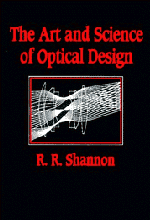7 - DESIGN EXAMPLES
Published online by Cambridge University Press: 05 June 2012
Summary
We will now deal with the application of the concepts discussed in the previous chapters by applying these methods to the design of a number of lenses. These examples have been selected to provide a view of the techniques used in design at several greater levels of complexity. The majority of this chapter will deal with the detailed design of somewhat traditional, or basic, design problems, as they actually provide the basis for most of the optics done in this world. Some of the newer opportunities for design will be discussed in the latter portion of the chapter.
The goals set for the designs are somewhat arbitrary, but realistic, versions of those encountered in real life. Expanding beyond these goals will serve as a good learning experience for any individual who wishes to increase his or her knowledge of the methods of lens design.
Several different design programs will be used in these examples. A difficulty with this is that it may lead to some confusion as to the meaning of various program-dependent features that are necessary in working with a computer. The great advantage is that the essential nature of the optical problems will emerge. The design programs used, CODE V, OSLO, and ZEMAX, happen to be those used by the author for many years in teaching a course in lens design at the Optical Sciences Center.
Information
- Type
- Chapter
- Information
- The Art and Science of Optical Design , pp. 388 - 603Publisher: Cambridge University PressPrint publication year: 1997
